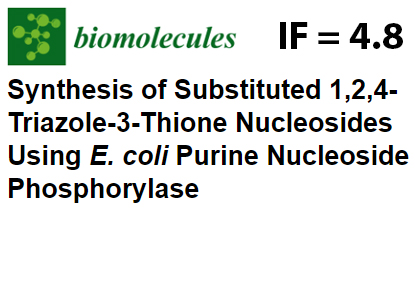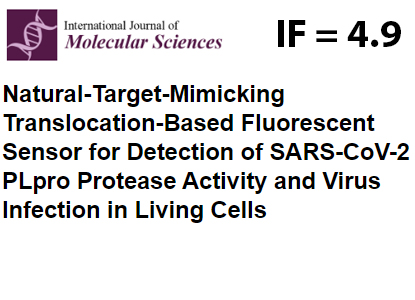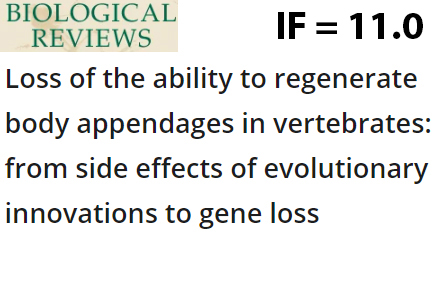Press-room / Digest

Synthesis of Substituted 1,2,4-Triazole-3-Thione Nucleosides Using E. coli Purine Nucleoside Phosphorylase
Scientists from the departments of biotechnology and structural biology (IBCH RAS) and Institute of the Chemistry of Plant Substances (Uzbekistan), and D. I. Ivanovsky Institute of Virology synthesized a series of substituted 1,2,4-triazole-3-thione nucleoside analogs and tested their antiviral activity against herpes simplex virus. 1,2,4-Triazole derivatives have a wide range of biological activities and finding new nucleosides based on it is a topical task. Three compounds from a series of synthesized mono- and disubstituted 1,2,4-triazole-3-thione derivatives were found to be substrates for E. coli purine nucleoside phosphorylase. For ribosides and deoxyribosides produced by enzymatic synthesis, it has been shown that the addition of carbohydrates to mono- and di-substituted 1,2,4-triazole-3-thiols occurs at different nitrogen atoms. All synthesised nucleosides and heterocyclic bases were tested for cytotoxicity and activity against herpes simplex virus 1. Compared to the antiviral drug ribavirin, the selectivity index for the two nucleosides was significantly higher. It was also found that as the lipophilicity of the compounds studied increased, both their activity and toxicity increased. The results are published in the Biomolecules (IF 4.8). Learn more

Natural-Target-Mimicking Translocation-Based Fluorescent Sensor for Detection of SARS-CoV-2 PLpro Protease Activity and Virus Infection in Living Cells
The papain-like protease PLpro plays a key role in the life cycle of the coronavirus SARS-CoV-2, making this enzyme a promising target for antiviral therapy. In this work a genetically encoded fluorescent sensor for PLpro activity was created. A distinctive feature of the sensor is its design closely mimicking the natural target of PLpro. A high-contrast translocation response (14-fold change in the signal ratio in the nucleus and cytoplasm) makes it possible to reliably detect PLpro activity in human cell cultures not only in the recombinant protease overexpression model, but also during infection with the SARS-CoV-2 virus, as a team of scientists from the Laboratory of genetically encoded molecular tools of IBCH RAS has shown in collaboration with Institute of Molecular Biology of the Russian Academy of Sciences and the Gamaleya Center for Epidemiology and Microbiology. The results are published in the International Journal of Molecular Sciences.

“Molecular portraits” characterized functional states of TRPV ion channels
TRPV ion channels realize a huge variety of functions in the human body participating in the temperature and pain sensation, cell division, calcium uptake. Researchers from IBCh RAS and Columbia University analyzed the structure of the key TRPV domain – the ion conducting pore. Using the original “dynamic molecular portrait” approach, they identified three major states of the pore that are common for all TRPVs, called α-closed, π-closed, and π-open. It was shown that the α-closed state is the most hydrophobic and always nonconducting. While the π-closed one is less stable and can easily transit to the open state, which has favorable hydrophobic properties for the ion conduction. The results were published in Communications Chemistry. Learn more

Immune system regulation for nanoparticle drug delivery. Breaking the endless cycle in nanomedicine
The journey of discovery in scientific research sometimes follows a familiar path: discover, admire, investigate, disappoint, and forget. Nevertheless, in some disciplines, it seems repeating many times. One of such cycles in the field of immune system blockade by nanoparticles is analysed in a recent article published in Nature Communications journal. Scientists from the Institute of Bioorganic Chemistry, Uppsala University and Boston University propose that advancements in nanomaterial development may finally disrupt this cycle, potentially introducing the method of macrophage blockade into clinical practice to improve cancer therapy. Learn more

Loss of Ability to regenerate Limbs in Higher Vertebrates: From Side Effects of Evolutionary Innovations to Gene Loss
Researchers from the Laboratory of Molecular Foundations of Embryogenesis at the GNC IBCh RAS have identified the main factors that rendered limb regeneration impossible in modern amniotes (reptiles, birds, and mammals). The authors suggested that after the ancestors of amniotes transitioned to land, their ability to regenerate limbs was suppressed by the side effects of various innovations that emerged at that time, which were necessary for successful colonization of land. This, in turn, stimulated the disappearance of many genes that ceased to participate in regeneration from that moment on. As a result, in modern amniotes, including humans, the inability to regenerate limbs became firmly fixed at the genomic level. The work was supported by the Russian Science Foundation grant 23-74-30005 and published in the journal Biological Reviews. Learn more

